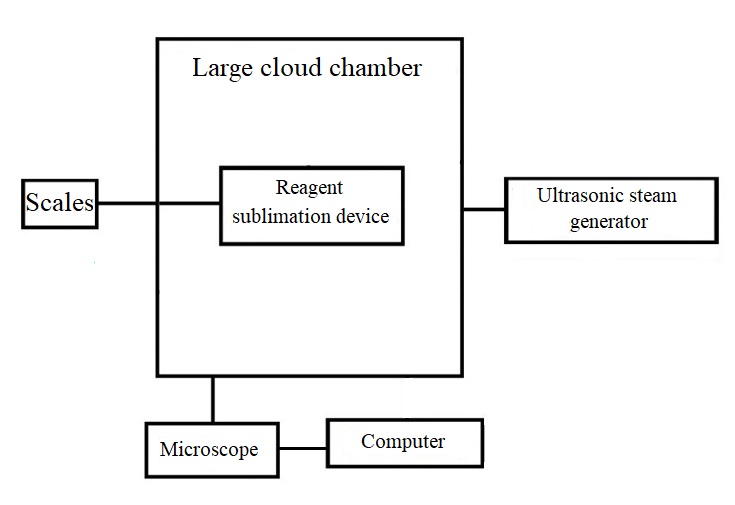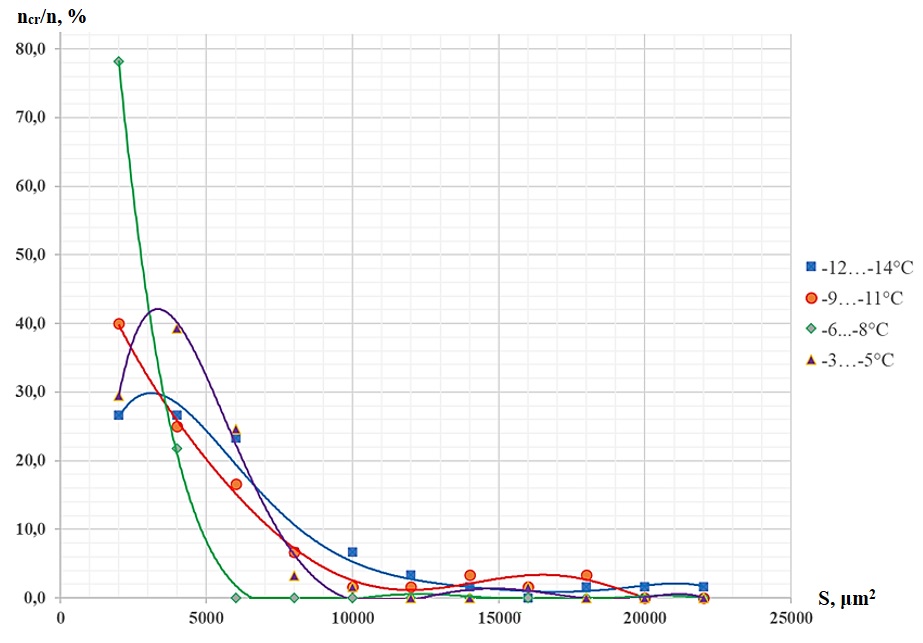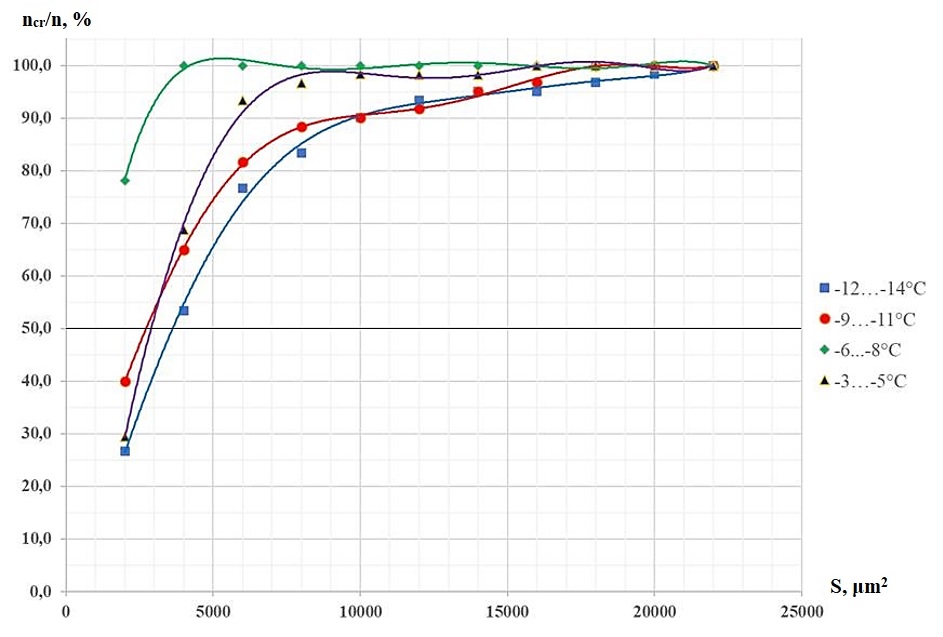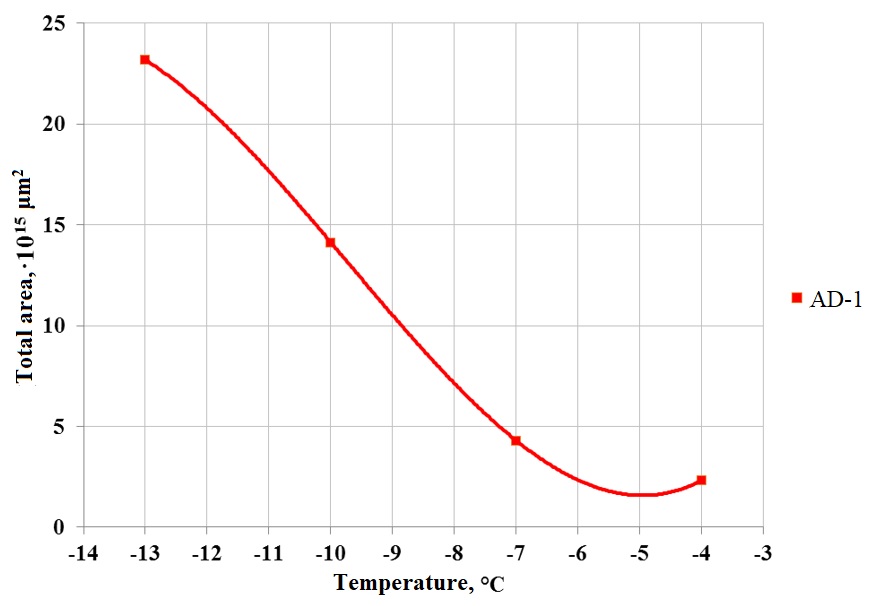Исследования льдообразующих свойств пиротехнического состава АД-1
Исследования льдообразующих свойств пиротехнического состава АД-1
Аннотация
Активные воздействия на облачные процессы с целью обеспечения благополучной жизнедеятельности человечества являются одной из основных задач метеорологии. В практике активных воздействий на облачные процессы широко используется штатный пиротехнический состав АД-1. Он входит в состав топливных зарядов маршевых ракетных двигателей, начиненных реагентом для оснащения противоградовых ракет. Пиросостав АД-1 содержит 8% иодистого серебра (AgI) и имеет порог кристаллизующей эффективности -3°С и разрушается при температуре выше 554 °С. В настоящее время иодид серебра остается самым эффективным льдообразующим реагентом. Удельный выход активных ядер на единицу массы AgI существенно превосходит соответствующие выходы для всех других реагентов этого типа при всех температурах активации. В связи с этим экспериментальные исследования механизмов образования льда на частицах пиротехнического состава АД-1 представляются актуальной задачей. Целью работы является исследование процессов льдообразования на частицах пиротехнического состава АД-1. Основными методами исследования являются лабораторное моделирование процессов взаимодействия облачной среды с частицами реагента, а также методы математической статистики для анализа полученных результатов. При проведении исследований впервые разработана аппаратура и методика для исследования процессов льдообразования, впервые исследованы ледяные кристаллы, формирующиеся на частицах пиротехнического состава АД-1. В результате проведения экспериментов получены лабораторного моделирования образования кристаллов льда на частицах пиротехнического состава АД-1, которые показали, что на частицах пиросостава АД-1 образуются кристаллы льда оптимальных размеров, что повышает эффективность данного реагента по сравнению с аналогами.
1. Introduction
Currently, much attention is paid to the development of methods and tools for managing cloud processes. Carrying out work on active effects requires solving a number of methodological issues, in particular, how, where, when and with what reagents active effects should be carried out in order to achieve optimal success.
When developing methods for managing cloud processes, a special place belongs to laboratory modeling of the key moments of active impacts. One of such key moments of active influences on cloud processes is the processes of ice crystal growth on reagent particles.
Modern concepts of active influences are based on changing the microphysical structure of clouds through reagents with specified physicochemical properties
, . The reagents used are mainly substances with ice-forming and condensation properties .The issue under study is in the field of cloud microphysics and precipitation. Since the first half of the 20th century, scientific work has been carried out in Russia and abroad to find effective reagents to combat hail, drought and to artificially cause precipitation. In these works, the effectiveness of reagents was investigated, weather modification tools were developed
, , , . But none of the studies touched upon the characteristics of ice crystals formed on reagent particles. The research is based on the specific yield of ice-forming nuclei. The specific yield of ice-forming nuclei and the temperature threshold of crystal formation are currently used as a measure of the effectiveness of reagents. The specific yield is the number of ice crystals formed in a cloud or fog at a given temperature per unit mass of the introduced substance or from one means of exposure .At the same time, the characteristics of its surface play an important role in the efficiency of water crystallization on a reagent particle
. However, the area of the crystals formed plays an important role. In this paper, the crystal area and specific yield are considered as an indicator of the effectiveness of reagents.
2. Research methods and principles
The aim of the work is to study the processes of ice formation on particles of the AD-1 pyrotechnic composition.
Achieving this goal required solving the following tasks:
1. Development of a complex of equipment for obtaining particles of AD-1 pyrotechnic composition in a cloud environment.
2. Development of a methodology for studying the ice-forming properties of the AD-1 pyrotechnic composition.
3. Investigation of ice crystals formed on particles of the AD-1 pyrotechnic composition using a mathematical apparatus.
The main research methods are laboratory modeling of the processes of interaction of the cloud environment with reagent particles, as well as methods of mathematical statistics for analyzing the results obtained. During the research, the equipment and methodology for the study of ice formation processes were developed for the first time, ice crystals formed on particles of the pyrotechnic composition AD-1 were studied for the first time.
The scheme of the equipment complex is shown in Figure 1. The equipment complex includes: a large cloud chamber, a reagent sublimation device, an ultrasonic steam generator, scales, an optical microscope and a computer (Figure 1).

Figure 1 - A set of equipment for studying the ice-forming properties of AD-1 pyrocomposition
The ultrasonic steam generator is placed inside a plastic container with a volume of 100 liters. The container is connected to a large chamber by a rubber pipe, a fan is installed on the lid of the container to create a steam flow into the chamber.
The device for sublimation of the reagent is a graphite substrate sandwiched between electrodes. An electric current of about 180-200 A is supplied to the electrodes, the substrate is heated to temperatures of the order of 1000 ºC and the reagent sublimes.
Thermostatic substrates for collecting crystals are small metal discs with diameter d = 4 cm, covered with clean glasses. The glasses are covered with lids that were opened at the moment of the appearance of crystals. Crystals settling at the bottom of the cloud chamber fall on the glass. Ice crystals are counted using an automated system.
Substrates are studied using an automated system, which consists of an optical microscope, a personal computer and specialized software. The calculation of the sizes and areas of ice crystals in different temperature ranges is carried out.
3. Main results
A series of experiments were carried out to study the ice-forming properties of particles of the AD-1 pyrotechnic composition. The experiments were carried out in the temperature range from -3 to -14 °C.
Table 1 and Figure 2 present data on the area of ice crystals that formed on particles of the AD-1 pyrotechnic composition in different temperature ranges. The ratios of crystals for different size ranges, ncr/n, % are given.
Table 1 - Dependence of the size of ice crystals formed on the particles of the pyrotechnic composition of AD-1 on the temperature
S, μm2 | Crystal ratio at different temperature values, ncr/n, % | |||
-12…-14 °С | -9…-11 °С | -6...-8 °С | -3…-5 °С | |
0-2000 | 26,7 | 40,0 | 78,2 | 29,5 |
2000-4000 | 26,7 | 25,0 | 21,8 | 39,3 |
4000-6000 | 23,3 | 16,7 | 0,0 | 24,6 |
6000-8000 | 6,7 | 6,7 | 0,0 | 3,3 |
8000-10000 | 6,7 | 1,7 | 0,0 | 1,6 |
10000-12000 | 3,3 | 1,7 | 0,0 | 0,0 |
12000-14000 | 1,7 | 3,3 | 0,0 | 0,0 |
14000-16000 | 0,0 | 1,7 | 0,0 | 1,6 |
16000-18000 | 1,7 | 3,3 | 0,0 | 0,0 |
18000-20000 | 1,7 | 0,0 | 0,0 | 0,0 |
20000-22000 | 1,7 | 0,0 | 0,0 | 0,0 |
Specific yield, г-1 | 4,8∙1012 | 3,5∙1012 | 3,0∙1012 | 7,0∙1011 |

Figure 2 - The area of ice crystals that formed on particles of the AD-1 pyrotechnic composition in different temperature ranges
Table 2 - Cumulative frequencies of crystal ratios formed on particles of AD-1 pyrotechnic composition
S, μm2 | Crystal ratio at different temperature values, ncr/n, % | |||
-12…-14 °С | -9…-11 °С | -6...-8 °С | -3…-5 °С | |
0-2000 | 26,7 | 40,0 | 78,2 | 29,5 |
2000-4000 | 53,4 | 65,0 | 100,0 | 68,8 |
4000-6000 | 76,7 | 81,7 | 100,0 | 93,4 |
6000-8000 | 83,4 | 88,4 | 100,0 | 96,7 |
8000-10000 | 90,1 | 90,1 | 100,0 | 98,3 |
10000-12000 | 93,4 | 91,8 | 100,0 | 98,3 |
12000-14000 | 95,1 | 95,1 | 100,0 | 98,3 |
14000-16000 | 95,1 | 96,8 | 100,0 | 100,0 |
16000-18000 | 96,8 | 100,0 | 100,0 | 100,0 |
18000-20000 | 98,5 | 100,0 | 100,0 | 100,0 |
20000-22000 | 100,0 | 100,0 | 100,0 | 100,0 |

Figure 3 - Cumulative frequencies of crystal ratios formed on particles of AD-1 pyrotechnic composition
When sublimating the AD-1 pyrotechnic composition, particles are formed with a diameter from 20 nm to 400 nm with a modal value of 70 nm. In this case, almost 100% activity of silver iodide is observed in the presence of particles with a diameter of 50 nm
.Table 3 and Figure 4 the total area of crystals that formed on particles of the AD-1 pyrotechnic composition in different temperature ranges.
Table 3 - The total area of crystals formed on the particles of the AD-1 pyrotechnic composition in different temperature ranges
S, μm2 | Crystal area, ·102 μm2 | |||
-12…-14 °С | -9…-11 °С | -6...-8 °С | -3…-5 °С | |
0-2000 | 12,74 | 14,00 | 23,46 | 2,07 |
2000-4000 | 38,21 | 26,25 | 19,62 | 8,25 |
4000-6000 | 55,57 | 29,23 | 0,0 | 8,61 |
6000-8000 | 22,37 | 16,42 | 0,0 | 1,62 |
8000-10000 | 28,76 | 5,36 | 0,0 | 1,01 |
10000-12000 | 17,32 | 6,55 | 0,0 | 0,0 |
12000-14000 | 10,54 | 15,02 | 0,0 | 0,0 |
14000-16000 | 0,0 | 8,93 | 0,0 | 1,68 |
16000-18000 | 13,79 | 19,64 | 0,0 | 0,0 |
18000-20000 | 15,41 | 0,0 | 0,0 | 0,0 |
20000-22000 | 17,03 | 0,0 | 0,0 | 0,0 |
- | Total area, ·1016 μm2 | |||
2,317 | 1,414 | 0,431 | 0,232 | |

Figure 4 - Distribution of the total area of crystals formed on particles of the AD-1 pyrotechnic composition by temperature
4. Conclusion
In the course of laboratory experiments, a method for studying the ice-forming properties of the AD-1 pyrotechnic composition has been developed.
When the AD-1 pyrotechnic composition is sublimated, particles with a diameter from 20 nm to 400 nm with a modal value of 70 nm are formed. Almost 100% activity of silver iodide is observed in the presence of particles with a diameter of 50 nm.
Up to 90% of the ice crystals formed on the particles of the AD-1 pyrocomposition have a surface area of up to 104 μm2 at temperatures from -9 to -14°C. At temperatures of the order of -3...-5°C, the proportion of ice crystals with a surface area of up to 8·103 μm2 reaches 95%. At temperatures of the order of -6...-8°C, the smallest crystals are formed, having a surface area not exceeding 4·103 μm2.
Most methods of hail prevention, artificial precipitation increase and fog dispersion are based on the following physical concepts:
- complete crystallization of the supercooled part of the cloud;
- competition theory;
- enlargement of droplets with their subsequent freezing;
- dynamic impact in order to suppress the upward flow;
- lowering the trajectory of hailstones;
- acceleration of sedimentation in the formation zone of hail generation conditions.
The impact of particles of the AD-1 pyrotechnic composition on the supercooled cloud environment leads to the formation of ice crystals having dimensions sufficient for the combined implementation of the above concepts. Therefore, the use of this reagent in weather modification is effective and widespread.
